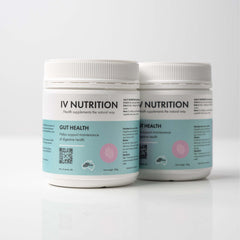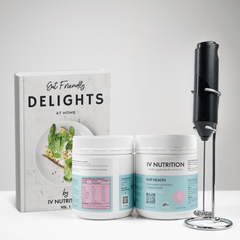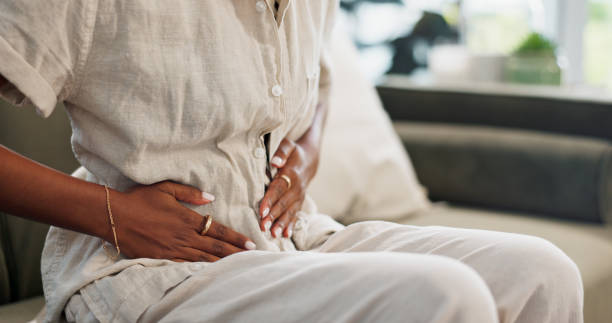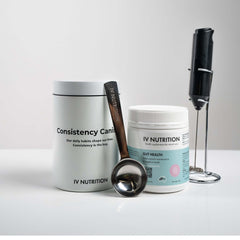The gut microbiome—the vast ecosystem of bacteria, fungi, and other microorganisms living inside your digestive tract—plays a vital role in health and wellbeing. It influences everything from digestion and immunity to mood and metabolism.
When this ecosystem is balanced, beneficial bacteria outnumber and control the harmful ones. But when that balance tips, “bad” bacteria can multiply and trigger a cascade of problems: bloating, fatigue, inflammation, poor digestion, and even skin issues like acne or eczema.
So, what naturally kills bad bacteria in the gut—and how can you restore balance safely and effectively?
In this in-depth guide, we’ll explore:
-
What causes bad bacteria to overgrow.
-
The symptoms of gut imbalance.
-
Natural strategies that help reduce harmful microbes.
-
The crucial role of prebiotic fibres in restoring microbial balance.
-
How IV Nutrition’s Virgin Manufactured Sugarcane Prebiotic Fibre can help strengthen gut health from the inside out.
Understanding “Good” and “Bad” Gut Bacteria
Not all bacteria are bad. In fact, many are essential. The gut is home to trillions of microorganisms that perform key functions, including:
-
Breaking down food into absorbable nutrients.
-
Producing vitamins like B12 and K2.
-
Regulating the immune system.
-
Maintaining the integrity of the intestinal barrier.
However, problems occur when “bad” or opportunistic bacteria overgrow. These harmful species can:
-
Produce toxins and inflammatory compounds.
-
Weaken the gut lining (“leaky gut”).
-
Disrupt nutrient absorption.
-
Trigger immune dysfunction and chronic inflammation.
The goal isn’t to eliminate all bacteria—it’s to restore balance so that beneficial microbes dominate and harmful ones are kept under control.
What Causes Bad Bacteria to Overgrow?
Several modern lifestyle factors contribute to microbial imbalance, also known as dysbiosis:
-
Processed Diets – Diets high in refined sugars, low in fibre, and rich in artificial additives feed harmful bacteria and starve beneficial ones.
-
Antibiotic Use – While antibiotics fight infection, they also wipe out large portions of beneficial bacteria.
-
Chronic Stress – Stress hormones alter gut motility and microbial diversity, favouring the growth of pathogenic strains.
-
Poor Sleep – Irregular sleep patterns affect microbial balance and intestinal barrier strength.
-
Alcohol and Toxins – Excess alcohol damages gut lining and promotes harmful bacterial activity.
-
Low Fibre Intake – Fibre is the main food source for beneficial microbes; without it, bad bacteria flourish.
Understanding these root causes is the first step toward restoring balance and eliminating harmful bacteria naturally.
Signs of Bad Bacteria Overgrowth
When harmful microbes dominate, symptoms can appear across multiple systems:
-
Bloating, gas, or abdominal discomfort.
-
Irregular bowel habits (constipation or diarrhoea).
-
Fatigue and brain fog.
-
Sugar cravings.
-
Skin breakouts or rashes.
-
Weakened immunity or frequent illness.
-
Unexplained weight fluctuations.
If you experience several of these symptoms, your gut may be signalling an imbalance.
What Naturally Kills Bad Bacteria in the Gut?
Restoring a healthy microbiome doesn’t require harsh cleanses or restrictive diets. The body naturally regulates microbial populations when given the right support. Below are the most effective, natural strategies for reducing harmful bacteria while strengthening the good.
1. Increase Dietary Fibre Intake
Fibre is the unsung hero of gut health. It’s the main food source for beneficial microbes. When good bacteria ferment fibre, they produce short-chain fatty acids (SCFAs) such as butyrate, which suppress the growth of harmful bacteria and strengthen the gut lining.
Without adequate fibre, harmful bacteria have the advantage. Increasing fibre intake through vegetables, legumes, and whole grains—or supplementing with prebiotics—can shift the balance back toward health.
2. Add Prebiotic Fibre
Prebiotic fibres are specific types of fibre that selectively feed beneficial bacteria, such as Bifidobacteria and Lactobacillus. As these populations grow, they naturally crowd out harmful species through competition for space and resources.
Prebiotics also enhance SCFA production, particularly butyrate, which lowers gut pH—creating an environment where “bad” bacteria struggle to survive.
3. Reduce Processed Foods and Sugars
Bad bacteria thrive on refined carbohydrates and processed foods. These feed opportunistic microbes and yeast species that disrupt balance. Eliminating added sugars and ultra-processed snacks is one of the fastest ways to starve harmful bacteria.
4. Eat Fermented Foods
Fermented foods like kefir, sauerkraut, kimchi, and yogurt contain naturally occurring probiotics that support microbial diversity. Adding them gradually can help repopulate the gut with beneficial species.
5. Stay Hydrated
Water helps maintain the mucosal layer that lines the intestines—a natural barrier that prevents harmful bacteria from attaching to the gut wall. Dehydration weakens this defence and slows digestion, allowing pathogens to proliferate.
6. Manage Stress
The gut and brain are deeply connected through the vagus nerve. Chronic stress increases gut permeability and disrupts microbial balance. Techniques like deep breathing, yoga, and meditation help lower cortisol levels, supporting microbial stability.
7. Get Adequate Sleep
Microbial rhythms follow our sleep-wake cycle. Poor sleep alters gut microbiota composition and promotes inflammation. Aim for 7–9 hours of quality sleep each night to allow your gut microbes to reset.
8. Avoid Unnecessary Antibiotics
Only use antibiotics when absolutely necessary. If you must take them, support recovery with prebiotics and a nutrient-rich diet to rebuild microbial diversity afterward.
9. Support Digestive Health with Prebiotic Fibre Supplements
While food is foundational, prebiotic fibre supplements can accelerate microbial balance restoration. They provide consistent, concentrated nourishment for beneficial bacteria—especially during recovery from imbalance or antibiotic use.
Spotlight: IV Nutrition’s Virgin Manufactured Sugarcane Prebiotic Fibre
Among available options, IV Nutrition’s Virgin Manufactured Sugarcane Prebiotic Fibre stands out as a clinically effective, clean, and gentle solution for improving gut balance.
Why It’s Different
-
Virgin manufactured: Extracted directly from sugarcane, not industrial byproducts, ensuring purity and potency.
-
Highly fermentable: Designed to fuel beneficial bacteria and enhance SCFA production.
-
Gentle and effective: Well tolerated, even by individuals with sensitive digestion.
-
Clean sourcing: Produced without unnecessary fillers or additives.
Key Benefits for Gut Health
-
Encourages the growth of beneficial bacteria.
-
Naturally suppresses harmful microbial overgrowth.
-
Strengthens the gut barrier and reduces inflammation.
-
Improves bowel regularity and nutrient absorption.
-
Supports immune health, energy, and skin clarity.
Special Offer: 100% OFF Your First Tub
You can try it risk-free with subscription:
Claim Your Free Tub Here
By consistently incorporating this prebiotic fibre, you provide the ideal environment for beneficial microbes to thrive—naturally crowding out harmful bacteria without harsh cleanses or medications.
10. Move Your Body
Exercise isn’t just good for muscles—it’s good for microbes too. Regular physical activity promotes microbial diversity and increases the abundance of beneficial bacteria. It also improves digestion and reduces inflammation throughout the body.
11. Include Gut-Healing Foods
During the process of rebalancing the gut, certain foods provide extra support:
-
Garlic and onions: Contain natural antimicrobial compounds that suppress harmful bacteria.
-
Ginger: Reduces inflammation and supports healthy digestion.
-
Green tea: Polyphenols in tea feed beneficial bacteria and reduce pathogenic species.
-
Leafy greens: High in fibre and phytonutrients that support microbial diversity.
-
Bone broth: Provides amino acids that support intestinal lining repair.
The Importance of Gut pH
Maintaining a slightly acidic environment in the colon is essential for balance. Beneficial bacteria thrive in this environment, while harmful microbes struggle. Prebiotics and fermented foods both contribute to maintaining this optimal gut pH, creating conditions where bad bacteria cannot multiply freely.
How Long Does It Take to Restore Balance?
The gut is remarkably adaptive. Positive changes can begin within a few days of improving diet and fibre intake. However, lasting balance requires consistency. Over 4–8 weeks of sustained fibre and prebiotic supplementation, microbial diversity and gut integrity typically strengthen significantly.
The Gut–Skin Connection
An often-overlooked benefit of reducing harmful gut bacteria is clearer skin. When the gut barrier is compromised and inflammation rises, the skin often reflects that imbalance. Supporting gut health with prebiotics not only improves digestion but also enhances skin clarity and reduces flare-ups related to acne or eczema.
Practical Steps for Restoring Balance
-
Start the day with hydration.
-
Add a daily prebiotic supplement such as sugarcane-derived fibre.
-
Eat a rainbow of vegetables to nourish microbial diversity.
-
Limit processed and sugary foods.
-
Incorporate gentle movement—even walking helps digestion.
-
Prioritise rest and stress management.
Over time, these small steps create a resilient gut environment that naturally keeps bad bacteria in check.
The Role of Consistency
Many people try to “detox” their gut quickly, but true microbial balance isn’t achieved through short-term cleanses—it’s maintained through consistent nourishment. Just as poor diet and stress gradually disrupt the microbiome, steady, healthy habits gradually restore it.
Prebiotics are particularly valuable here because they work quietly and steadily, creating long-term shifts in microbial composition.
When to Seek Further Support
If symptoms like severe bloating, chronic fatigue, or persistent irregularity continue despite lifestyle changes, it may be helpful to do a microbiome test or work with a gut health specialist. However, most people can achieve significant improvements naturally through dietary balance and consistent prebiotic support.
Conclusion
So, what naturally kills bad bacteria in the gut? The answer lies not in eliminating all microbes, but in nurturing the right ones. Diet, hydration, rest, and fibre—especially prebiotic fibre—work together to restore microbial balance.
By fuelling beneficial bacteria, prebiotics indirectly suppress harmful species, strengthen gut integrity, and reduce inflammation throughout the body.
IV Nutrition’s Virgin Manufactured Sugarcane Prebiotic Fibre is one of the most effective tools for achieving this balance—gentle, pure, and clinically relevant for anyone seeking lasting gut health.
Restoring your microbiome doesn’t require extreme measures—just consistent care, nourishment, and the right daily support





